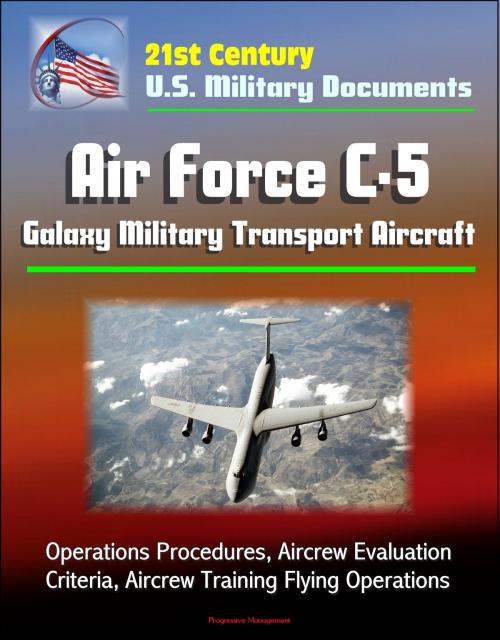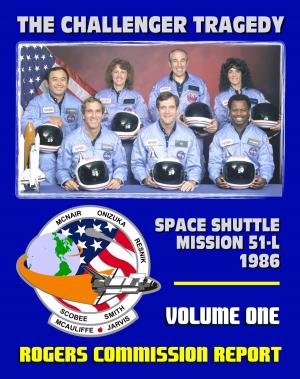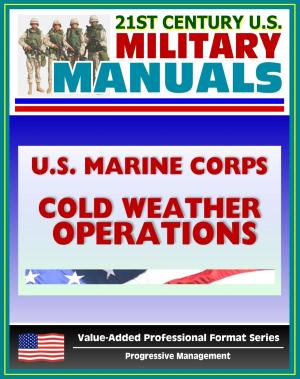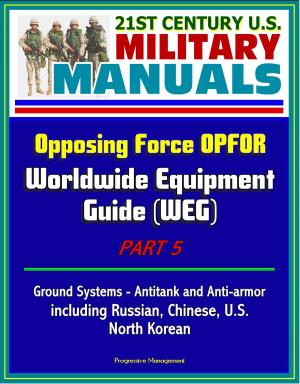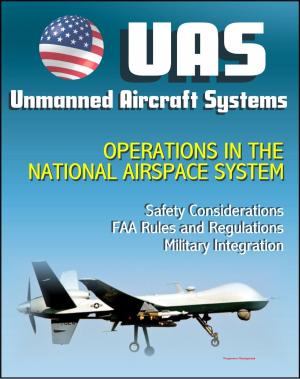21st Century U.S. Military Documents: Air Force C-5 Galaxy Military Transport Aircraft - Operations Procedures, Aircrew Evaluation Criteria, Aircrew Training Flying Operations
Nonfiction, Science & Nature, Technology, Aeronautics & Astronautics, History, Military, Aviation| Author: | Progressive Management | ISBN: | 9781310508394 |
| Publisher: | Progressive Management | Publication: | October 29, 2013 |
| Imprint: | Smashwords Edition | Language: | English |
| Author: | Progressive Management |
| ISBN: | 9781310508394 |
| Publisher: | Progressive Management |
| Publication: | October 29, 2013 |
| Imprint: | Smashwords Edition |
| Language: | English |
Three Air Force documents provide unique information about USAF operations of this aircraft.
Contents: C-5 Operations Procedures * C-5 Aircrew Evaluation Criteria * C-5 Aircrew Training
Chapter 1 * GENERAL INFORMATION * 1.1. General * 1.2. Applicability * 1.3. Key Words Explained * 1.4. Deviations and Waivers * 1.5. Supplemental Procedures * 1.6. Local Supplement Coordination Process * 1.7. Improvement Recommendations * 1.8. Definitions * 1.9. Aircrew Operational Reports * Chapter 2 * COMMAND AND CONTROL * 2.1. General * 2.2. Execution Authority * 2.3. Pilot in Command (PIC) Responsibility and Authority * 2.4. Mission Clearance Decision * 2.5. Operational C2 Reporting * 2.6. Mission Commander (MC) * 2.7. C2 Agency Telephone Numbers * 2.8. Close Watch Missions * 2.9. Law Enforcement Support * 2.10. En route Maintenance Support * Chapter 3 * AIRCREW COMPLEMENT/MANAGEMENT * 3.1. General * 3.2. Aircrew Complement * 3.3. Aircrew Member Qualification * 3.4. Pilots * 3.5. Not Used * 3.6. Flight Engineers and Loadmasters * 3.7. Aircrew Management * 3.8. Scheduling Restrictions * 3.9. Fatigue Countermeasures Management Program * 3.10. Crew Rest/En route Ground Time * 3.11. Alerting Procedures * 3.12. Stage Management * 3.13. Standby Force Duty * 3.14. Orientation Flights and Incentive Flights * 3.15. Interfly * 3.16. Mission Essential Personnel (MEP) * 3.17. Mission Mobility Observers (MMO) * Chapter 4 * AIRCRAFT OPERATING RESTRICTIONS * 4.1. Objective * 4.2. Minimum Equipment List (MEL) Policy * 4.3. Waiver Protocol * 4.4. Technical Assistance * 4.5. MEL Table Definitions/Column Identifiers * 4.6. C-5 MEL * 4.7. Supplements * 4.8. One Engine Inoperative Ferry Flights * 4.9. Landing Gear * 4.10. SLATS INOPERATIVE * 4.11. Fuel System * 4.12. MADAR operational procedures * 4.13. FSS Servicing * 4.14. Landing Gear * 4.15. SLATS INOPERATIVE * 4.16. Fuel System * 4.17. MADAR operational procedures * 4.18. FSS Servicing * 4.19. Landing Gear * 4.20. SLATS INOPERATIVE * 4.21. Fuel System * 4.22. FSS Servicing * Chapter 5 * OPERATIONAL PROCEDURES * 5.1. Checklists * 5.2. Duty Station * 5.3. Flight Station Entry * 5.4. Takeoff and Landing Policy * 5.5. Landing Gear and Flap Operating Policy * 5.6. Outside Observer/Jump Seat Duties * 5.7. Seat Belts * 5.8. Aircraft Lighting * 5.9. Portable Electronic Devices * 5.10. Tobacco Use on Air Force Aircraft * 5.11. Advisory Calls * 5.12. Stabilized Approach * 5.13. Communications Policy * 5.14. Crew Resource Management (CRM)/Threat and Error Management * 5.15. Use of Automation * 5.16. Transportation of Pets * 5.17. Alcoholic Beverages * 5.18. Runway, Taxiway, and Airfield Requirements * 5.19. Aircraft Taxi and Taxi Obstruction Clearance Criteria and Foreign Object Damage (FOD) Avoidance * 5.20. Fuel Jettison Procedures * 5.21. Aircraft Speed * 5.22. Bird/Wildlife Aircraft Strike Hazard (BASH) Programs * 5.23. Functional Check Flights (FCFs), Acceptance Check Flights (ACFs) and Operational Check Flights (OCFs) * 5.24. Participation in Aerial Events * 5.25. Traffic Alerting and Collision Avoidance System (TCAS) * 5.26. Radar Altimeter * 5.27. Reduced Power Takeoffs * 5.28. Aircraft Recovery from Unprepared Surfaces * 5.29. Aircrew Fatigue * 5.30. Aviation Safety Action Program (ASAP) * Chapter 6 * AIRCREW PROCEDURES * Section 6A—Pre-Mission * 6.1. Aircrew Uniform * 6.2. Personal Requirements * 6.3. Pre-Mission Actions * 6.4. Aircrew Publications Requirements * 6.5. Airfield Review * 6.6. Aircrew Intelligence Briefing * Section 6B—Pre-departure * 6.7. Global Decision Scheduling System 2 (GDSS2) Account * 6.8. Flight Crew Information File (FCIF) * 6.9. Flight Crew Bulletins (FCB) * 6.10. Mission Kits * 6.11. Route Navigation Kits * 6.12. Briefing Requirements * 6.13. Call Signs * 6.14. Instrument Flight Rules * 6.15. Flight Plan/Data Verification * 6.16. Departure Planning * 6.17. Weather Minimums for Takeoff use Table 6 * 6.18. Alternate Planning * 6.19. Departure Alternates
Three Air Force documents provide unique information about USAF operations of this aircraft.
Contents: C-5 Operations Procedures * C-5 Aircrew Evaluation Criteria * C-5 Aircrew Training
Chapter 1 * GENERAL INFORMATION * 1.1. General * 1.2. Applicability * 1.3. Key Words Explained * 1.4. Deviations and Waivers * 1.5. Supplemental Procedures * 1.6. Local Supplement Coordination Process * 1.7. Improvement Recommendations * 1.8. Definitions * 1.9. Aircrew Operational Reports * Chapter 2 * COMMAND AND CONTROL * 2.1. General * 2.2. Execution Authority * 2.3. Pilot in Command (PIC) Responsibility and Authority * 2.4. Mission Clearance Decision * 2.5. Operational C2 Reporting * 2.6. Mission Commander (MC) * 2.7. C2 Agency Telephone Numbers * 2.8. Close Watch Missions * 2.9. Law Enforcement Support * 2.10. En route Maintenance Support * Chapter 3 * AIRCREW COMPLEMENT/MANAGEMENT * 3.1. General * 3.2. Aircrew Complement * 3.3. Aircrew Member Qualification * 3.4. Pilots * 3.5. Not Used * 3.6. Flight Engineers and Loadmasters * 3.7. Aircrew Management * 3.8. Scheduling Restrictions * 3.9. Fatigue Countermeasures Management Program * 3.10. Crew Rest/En route Ground Time * 3.11. Alerting Procedures * 3.12. Stage Management * 3.13. Standby Force Duty * 3.14. Orientation Flights and Incentive Flights * 3.15. Interfly * 3.16. Mission Essential Personnel (MEP) * 3.17. Mission Mobility Observers (MMO) * Chapter 4 * AIRCRAFT OPERATING RESTRICTIONS * 4.1. Objective * 4.2. Minimum Equipment List (MEL) Policy * 4.3. Waiver Protocol * 4.4. Technical Assistance * 4.5. MEL Table Definitions/Column Identifiers * 4.6. C-5 MEL * 4.7. Supplements * 4.8. One Engine Inoperative Ferry Flights * 4.9. Landing Gear * 4.10. SLATS INOPERATIVE * 4.11. Fuel System * 4.12. MADAR operational procedures * 4.13. FSS Servicing * 4.14. Landing Gear * 4.15. SLATS INOPERATIVE * 4.16. Fuel System * 4.17. MADAR operational procedures * 4.18. FSS Servicing * 4.19. Landing Gear * 4.20. SLATS INOPERATIVE * 4.21. Fuel System * 4.22. FSS Servicing * Chapter 5 * OPERATIONAL PROCEDURES * 5.1. Checklists * 5.2. Duty Station * 5.3. Flight Station Entry * 5.4. Takeoff and Landing Policy * 5.5. Landing Gear and Flap Operating Policy * 5.6. Outside Observer/Jump Seat Duties * 5.7. Seat Belts * 5.8. Aircraft Lighting * 5.9. Portable Electronic Devices * 5.10. Tobacco Use on Air Force Aircraft * 5.11. Advisory Calls * 5.12. Stabilized Approach * 5.13. Communications Policy * 5.14. Crew Resource Management (CRM)/Threat and Error Management * 5.15. Use of Automation * 5.16. Transportation of Pets * 5.17. Alcoholic Beverages * 5.18. Runway, Taxiway, and Airfield Requirements * 5.19. Aircraft Taxi and Taxi Obstruction Clearance Criteria and Foreign Object Damage (FOD) Avoidance * 5.20. Fuel Jettison Procedures * 5.21. Aircraft Speed * 5.22. Bird/Wildlife Aircraft Strike Hazard (BASH) Programs * 5.23. Functional Check Flights (FCFs), Acceptance Check Flights (ACFs) and Operational Check Flights (OCFs) * 5.24. Participation in Aerial Events * 5.25. Traffic Alerting and Collision Avoidance System (TCAS) * 5.26. Radar Altimeter * 5.27. Reduced Power Takeoffs * 5.28. Aircraft Recovery from Unprepared Surfaces * 5.29. Aircrew Fatigue * 5.30. Aviation Safety Action Program (ASAP) * Chapter 6 * AIRCREW PROCEDURES * Section 6A—Pre-Mission * 6.1. Aircrew Uniform * 6.2. Personal Requirements * 6.3. Pre-Mission Actions * 6.4. Aircrew Publications Requirements * 6.5. Airfield Review * 6.6. Aircrew Intelligence Briefing * Section 6B—Pre-departure * 6.7. Global Decision Scheduling System 2 (GDSS2) Account * 6.8. Flight Crew Information File (FCIF) * 6.9. Flight Crew Bulletins (FCB) * 6.10. Mission Kits * 6.11. Route Navigation Kits * 6.12. Briefing Requirements * 6.13. Call Signs * 6.14. Instrument Flight Rules * 6.15. Flight Plan/Data Verification * 6.16. Departure Planning * 6.17. Weather Minimums for Takeoff use Table 6 * 6.18. Alternate Planning * 6.19. Departure Alternates
